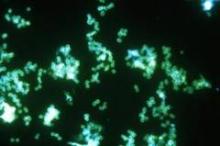ATLANTA – Gonorrhea reinfection rates are high among women in Florida, with more than 1 in 4 becoming reinfected after treatment, according to a review of surveillance data.
Of 9,923 female Florida residents with a reported gonorrhea infection in 2000, 27% had an additional infection reported within 10 years, and of 9,617 women with a gonorrhea infection reported in 2011, 23% had an earlier infection reported in the previous 10 years, Daniel R. Newman of the Centers for Disease Control and Prevention, Atlanta, reported in a poster at a conference on STD prevention sponsored by the CDC.
During 2000-2011, there were 127,081 gonorrhea infections reported among 103,156 women and girls aged 13 years and older, and the number of infections per year ranged from 9,345 to 11,970. Repeat infections occurred in 17,500 individuals.
The mean time to reported reinfection was 2.1 years; the median time was 1.28 years, Mr. Newman noted.
Most reinfections (74%) occurred in African Americans at a median age of 19 years at first diagnosis; 22% of African American women and girls and 14% of white women and girls with an infection in 2000 were reinfected at least once over the next decade, highlighting a 57% racial disparity in reinfection rates.
Additionally, 16% of 1,059 women who were HIV positive at the time of their first reported gonococcal infection were reinfected, indicating possible risk of HIV transmission to partners.
Since gonorrhea is often asymptomatic, and since a history of infections prior to 2000 was unavailable, it is likely that these findings underestimate the incidence of gonorrhea infection and reinfection, Mr. Newman reported.
Also, some women with an initial gonorrhea infection may have left the state after their initial infection; thus reinfection in those women would not have been captured, and some women may have moved to the state after an initial infection and thus would not be listed as a repeater.
The findings underscore the need to follow recommendations regarding rescreening of patients with gonorrhea after their initial diagnosis, Mr. Newman concluded, noting that partner services, including expedited partner therapy, and high-intensity behavioral counseling have been shown to reduce reinfection rates.
Mr. Newman reported having no disclosures.

